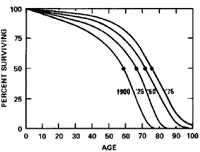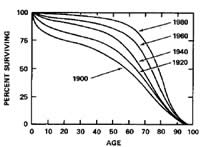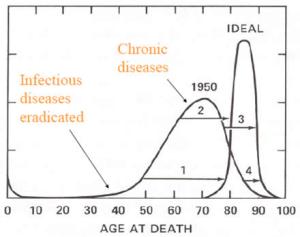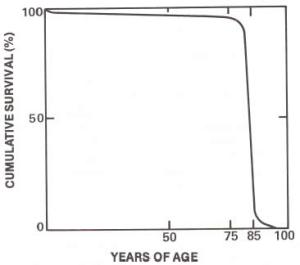Tags
In the last post on this topic, I concluded that
“As an optimist, when I look at this data, it looks very encouraging to me. First, it is definitely viable to live to 120. It has already been done! Like the four-minute mile, someone has already shown the way.
Second, an increasing number of people are approaching that age with an increasing rate. So, at this rate, I expect by the time my time arrives, dying at 120 will be as routine as dying at 100 today! It might not be very common, but it might not be that rare.”
While I make this informal and what seems like a rather obvious deduction from the data, some folks disagree.
James F. Fries and Lawrence M. Crapo in their book on Vitality and Aging make a compelling argument: while life expectancy has been increasing over the last many decades life-span has been fixed (for all practical purposes – increasing only by 0.1 year per century).
So, intuitively, the chart below may be how one would be tempted to guess the shape of life expectancy curves.

However, they argue, that it is the chart below that corresponds to the reality.
Thus according to their conclusion, while on an average humans are living longer and longer, we are still stuck at dying by the age of 100.
Presenting the data from another perspective in the chart below, as we graph number of deaths against age of death, we observe a normal or Gaussian distribution around certain age at which number of deaths peak. As the life expectancy keeps increasing the curve would look like the IDEAL curve below.
And, as that happens, graph of percent survial rate against age will become “rectanguar” as shown below.
This implies that as we conquer chronic diseases, we will live a healthy long life after which we will succumb very quickly to the forces of nature, within the bounds of a very few years. And, that will define an ideal “natural” death. As we hit certain time limit, all of the cells in the body may burst together like soap bubbles.
Fries and Crapo wrote their book in 1981. So I thought, with all the new research in the last 30+ years, maybe they have changed their mind.
In a more recent review article in the Journal of Aging Research, Compression of Morbidity 1980–2011: A Focused Review of Paradigms and Progress, James F. Fries, Bonnie Bruce, and Eliza Chakravarty reassert the same conclusion and buttress it with more recent studies.
I really like most everything else they assert, derive or conclude in that book- which I would like to talk about in a different post. However, I am personally not sold on this idea of fixed life-span.
It makes me quite uncomfortable. Yeah, you guessed it. After all, my goal is to purposely live to 120!
What do you think?
Have you seen any data, studies or analysis that contradicts this theory about fixed life-span?



It’s a very interesting topic and it made me start thinking differently. Instead of thinking of the next 5 to 10 years, I will think of the next 70 years of life ahead. My perspective on living to 120 is that 90% of the game is about mindset. I am excited to read more.
I realise this is a post from a while back, but I would like to use the graph showing when infectious diseases are eradicated and the ‘ideal’ compression in an essay – do you know where you got it from?
The whole discussion with the four charts is excerpted from Vitality and Ageing: Implications of the Rectangular Curve Hardcover – October, 1981 by James F. Fries (Author), L.M. Crapo (Author). Link to the book at Amazon is in the blog itself. I also refer to in the blog their 30 year later paper. The link will take you to the appropriate reference. Trust this is what you are looking for.
Everything is very open with a very clear explanation of the challenges.
It was really informative. Your website is useful. Many thanks
for sharing!